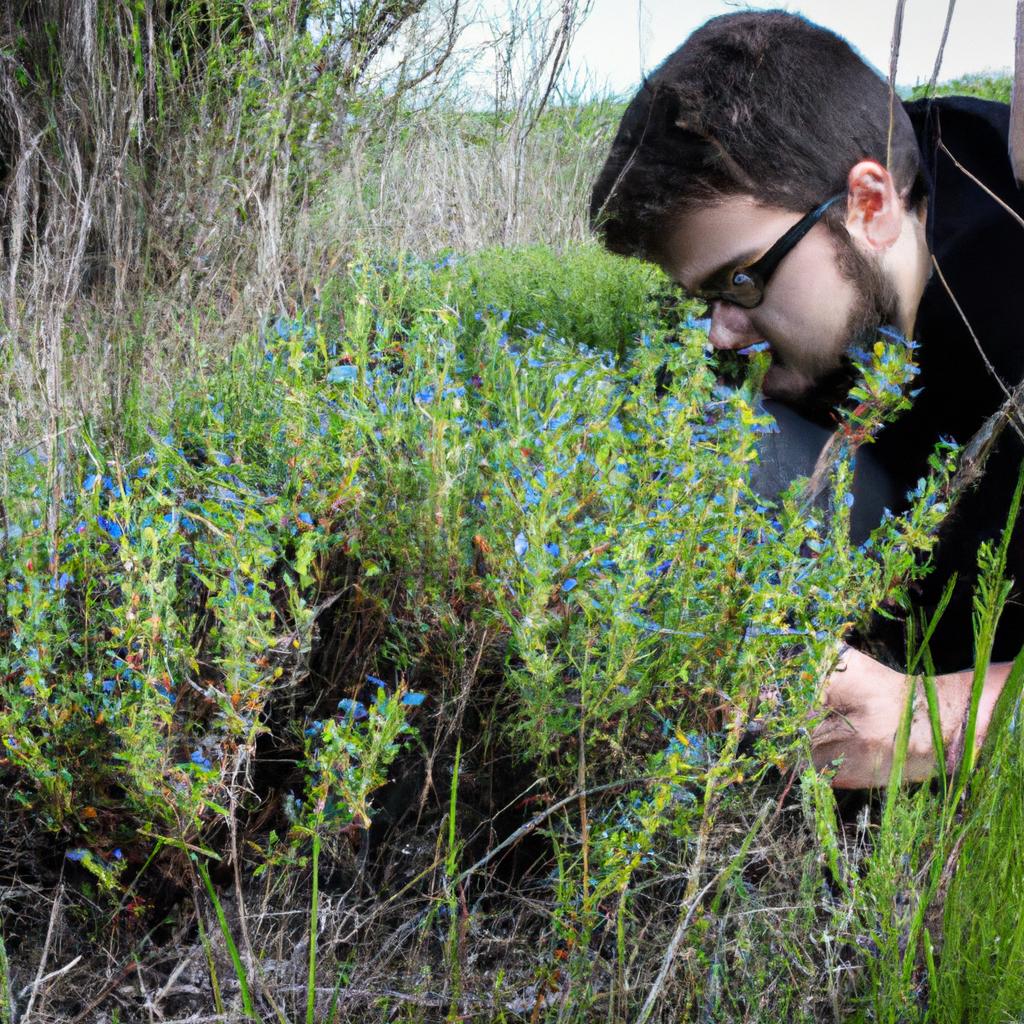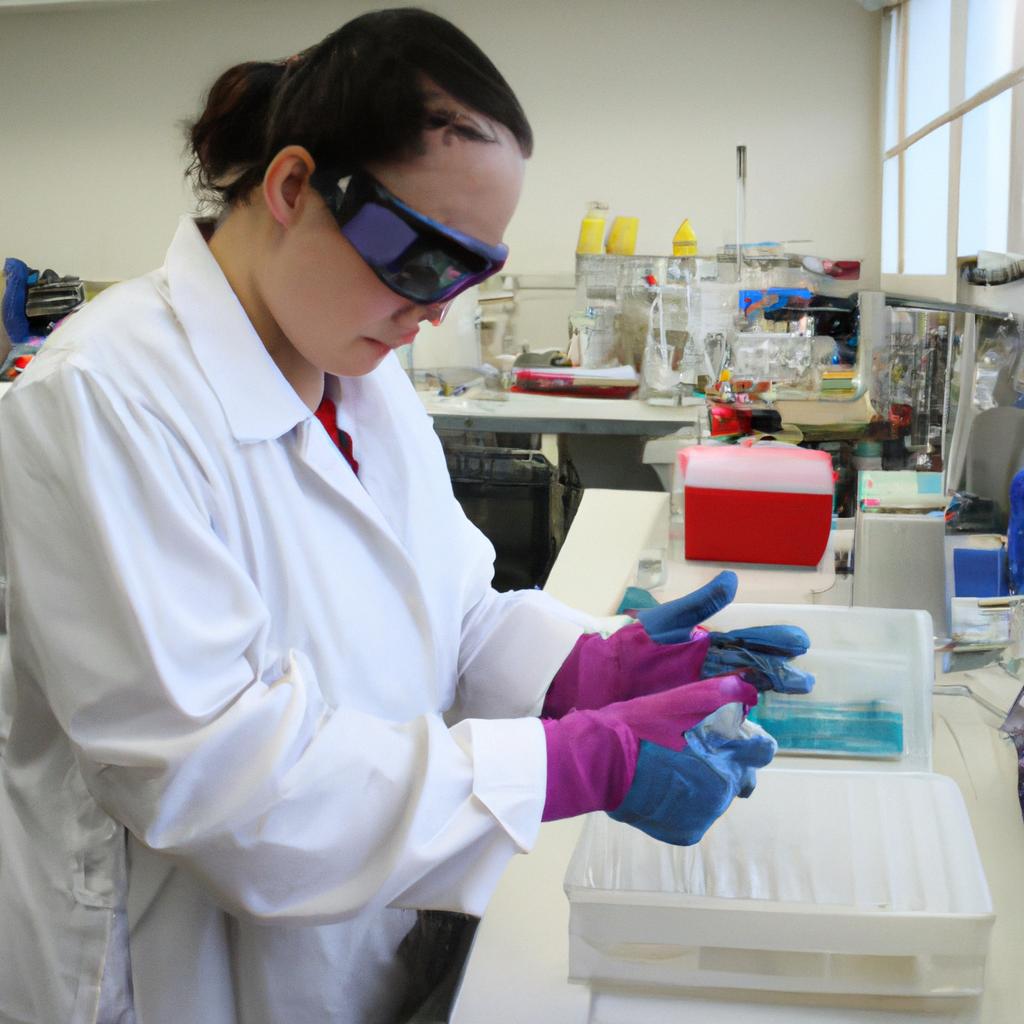Biogeochemical Cycles in Ecology: An Informative Overview

Biogeochemical cycles play a crucial role in the functioning of ecosystems, ensuring the continuous flow of essential elements necessary for life. These cycles involve the movement and transformation of elements such as carbon, nitrogen, phosphorus, and water between living organisms and their environment. Understanding these intricate processes is vital for comprehending ecosystem dynamics and addressing environmental challenges effectively. To illustrate the significance of biogeochemical cycles, let us consider an example involving the nitrogen cycle: imagine a hypothetical forest ecosystem where excessive levels of nitrogenous compounds are introduced through human activities like fertilization. This disturbance can lead to detrimental consequences such as eutrophication in nearby rivers or lakes, disrupting aquatic life and affecting overall ecological balance.
In this article, we will provide an informative overview of biogeochemical cycles in ecology, focusing on four key cycles: carbon, nitrogen, phosphorus, and water. By exploring each cycle’s components, processes, and interactions with living organisms and abiotic factors, readers will gain insights into how these cycles shape our natural world. Additionally, we will delve into the various human impacts that have disrupted these delicate balances over time—such as deforestation practices altering carbon cycling patterns or excessive fertilizer use disturbing nutrient flows—and discuss potential solutions to mitigate these issues and restore the health of ecosystems.
To begin, let’s examine the carbon cycle. Carbon is a fundamental building block of life and exists in various forms, including atmospheric carbon dioxide (CO2), organic matter in living organisms, and fossil fuels. The carbon cycle involves the movement of carbon between these different reservoirs through processes such as photosynthesis, respiration, decomposition, and combustion. Plants take in CO2 from the atmosphere during photosynthesis and convert it into organic compounds, storing carbon in their tissues. When plants and animals respire or decompose, they release CO2 back into the atmosphere. Additionally, human activities like burning fossil fuels contribute to the release of excess CO2, leading to climate change.
Next is the nitrogen cycle. Nitrogen is an essential nutrient for all living organisms and is required for protein synthesis and other vital biological processes. The nitrogen cycle involves multiple transformations of nitrogen between different forms such as atmospheric nitrogen gas (N2), ammonium (NH4+), nitrate (NO3-), and organic nitrogen compounds. Nitrogen fixation by certain bacteria converts N2 from the atmosphere into a usable form for plants. Plants take up nitrogen through their roots and incorporate it into their tissues. Animals obtain nitrogen by consuming plants or other animals. Decomposition returns nitrogen to the soil or water as ammonium, which can then be converted into nitrate by nitrifying bacteria or taken up by plants directly.
Moving on to phosphorus, this element plays a crucial role in energy transfer within cells (as ATP) and is a component of DNA and RNA molecules. Unlike carbon and nitrogen cycles, phosphorus does not have a significant gaseous phase but primarily cycles through terrestrial and aquatic systems. Weathering of rocks releases phosphate ions (PO4^3-) into soil or water bodies where it becomes available for uptake by plants. Plants incorporate phosphate ions into their tissues, which are then consumed by animals. Phosphorus is returned to the environment through excretion, decomposition, or erosion of rocks and sediments.
Lastly, we have the water cycle, also known as the hydrological cycle. Water is continuously cycled between the atmosphere, land, and bodies of water. The processes involved in this cycle include evaporation, condensation, precipitation, runoff, infiltration into soil, and transpiration by plants. Solar energy drives evaporation from oceans, lakes, and rivers into the atmosphere where it cools and condenses to form clouds. Precipitation occurs when condensed water vapor falls back to Earth as rain or snow. Once on land or in bodies of water, water can be stored temporarily before being evaporated again or flowing into rivers and eventually returning to the ocean.
Understanding these biogeochemical cycles allows us to recognize the interconnectedness of ecosystems and human activities with the environment. By studying how disruptions to these cycles occur through deforestation, pollution, climate change, or excessive nutrient inputs like fertilizers, we can devise strategies to mitigate harmful impacts and restore balance. These may include sustainable land management practices that promote carbon sequestration or reducing nitrogen and phosphorus runoff from agriculture.
In conclusion, biogeochemical cycles are essential for maintaining ecosystem health and functioning. By comprehending their components and processes alongside human influences on these cycles, we can work towards preserving our natural world for future generations.
The Concept of Biogeochemical Cycles
Biogeochemical cycles play a crucial role in maintaining the balance of nutrients and elements within ecosystems. These cycles involve the movement and transformation of substances, such as carbon, nitrogen, phosphorus, and water, through different components of the Earth system – the atmosphere, lithosphere (earth’s crust), hydrosphere (water bodies), and biosphere (living organisms). Understanding these cycles is essential for comprehending how ecosystems function and respond to environmental changes.
To illustrate the concept further, let us consider the carbon cycle as an example. Carbon exists in various forms on Earth – it can be found in the atmosphere as carbon dioxide gas, dissolved in water bodies as bicarbonate ions or organic matter, stored within rocks and sediments as calcium carbonate compounds, or present within living organisms. Through processes like photosynthesis by plants and respiration by animals, carbon moves between these reservoirs over time. This continuous cycling ensures that carbon remains available for use by living organisms while also regulating greenhouse gas concentrations in our atmosphere.
When examining biogeochemical cycles more broadly, several key aspects become apparent:
- Interconnectedness: The different cycles are interconnected; changes in one cycle can influence others. For instance, alterations in atmospheric nitrogen levels may impact both terrestrial and aquatic ecosystems.
- Reservoirs: Each element involved has various reservoirs where it can be stored temporarily or permanently. Some examples include forests acting as carbon sinks or oceans serving as major stores of nitrogen.
- Fluxes: Fluxes refer to the pathways through which elements move between reservoirs. These fluxes can occur naturally but may also be influenced by human activities such as deforestation or industrial emissions.
- Timescales: Biogeochemical cycles operate on different timescales ranging from short-term processes like daily nutrient uptake by plants to long-term geological transformations occurring over millions of years.
Emphasizing the significance of these cycles, it becomes evident that they are vital for sustaining life on Earth. Through their intricate dynamics, biogeochemical cycles support ecosystem health and stability by providing essential nutrients to organisms, regulating climate patterns, and maintaining environmental quality.
Transitioning into the subsequent section about “The Importance of Nutrient Cycling,” we can delve deeper into how these processes contribute to ecological functioning and highlight their relevance in various aspects of our lives.
The Importance of Nutrient Cycling
Biogeochemical cycles are essential processes in ecology that regulate the movement and transformation of nutrients through various components of ecosystems. Understanding the importance of nutrient cycling is crucial for comprehending how these cycles contribute to the overall functioning and sustainability of natural systems.
Consider, for instance, a hypothetical case study involving a forest ecosystem. In this scenario, fallen leaves from trees decompose on the forest floor, releasing nutrients such as nitrogen and phosphorus into the soil. These nutrients are then taken up by tree roots, promoting their growth and development. The trees provide habitat for numerous organisms, including birds and insects. When these organisms die or produce waste materials, they further contribute to nutrient cycling by returning organic matter back to the soil.
Nutrient cycling plays a fundamental role in ecological systems due to several reasons:
-
Nutrient availability: Through biogeochemical cycles, essential elements like carbon, nitrogen, phosphorus, and others are continuously recycled within ecosystems. This recycling ensures that these vital nutrients remain available for use by different organisms at all trophic levels.
-
Energy flow: Biogeochemical cycles facilitate energy transfer between living organisms and their environment. For example, during photosynthesis, plants convert solar energy into chemical energy stored in organic compounds. This energy is subsequently transferred when herbivores consume plant material and carnivores feed on herbivores.
-
Ecosystem stability: Nutrient cycling helps maintain stable conditions within ecosystems by regulating factors such as nutrient concentration and pH levels in soil and water bodies. This stability supports biodiversity by providing suitable conditions for diverse species to thrive.
-
Environmental impact: Changes in biogeochemical cycles can have significant environmental consequences. For instance, human activities such as deforestation or excessive fertilizer application can disrupt natural nutrient cycling patterns leading to eutrophication of aquatic systems or reducing soil fertility.
To illustrate the interconnectedness of biogeochemical cycles further, consider Table 1 below, which displays the key elements involved in different cycles:
| Biogeochemical Cycle | Key Elements Involved |
|---|---|
| Carbon cycle | Carbon dioxide (CO2), organic carbon |
| Nitrogen cycle | Nitrogen gas (N2), ammonia (NH3) |
| Phosphorus cycle | Inorganic phosphate (PO4^3-) |
| Water cycle | Water molecules |
As we delve deeper into understanding biogeochemical cycles, it is crucial to focus on one of the most prominent examples – the carbon cycle. This key biogeochemical cycle influences Earth’s climate and plays a vital role in supporting life as we know it.
[Transition Sentence]: Moving forward, let us explore The Carbon Cycle: A Key Biogeochemical Cycle and its significance within ecological systems.
The Carbon Cycle: A Key Biogeochemical Cycle
In the previous section, we explored the crucial role of nutrient cycling in ecological systems. Now, let us delve into one of the most significant biogeochemical cycles – the carbon cycle. Understanding this cycle is essential for comprehending how carbon moves through various reservoirs on Earth and impacts global climate patterns.
To illustrate the significance of the carbon cycle, consider a hypothetical case study involving a dense forest ecosystem. As trees undergo photosynthesis, they absorb atmospheric carbon dioxide (CO2) and convert it into organic compounds. These compounds are then stored within their biomass or released back into the atmosphere through respiration or decomposition upon death. This continuous interchange of carbon between living organisms, soil, air, and water exemplifies the intricate nature of the carbon cycle.
Now, let us explore some key features that evoke an emotional response when contemplating the immense impact of the carbon cycle:
- Climate Regulation: Through its influence on greenhouse gas concentrations, particularly CO2 levels, the carbon cycle plays a pivotal role in regulating Earth’s climate.
- Ocean Acidification: Excessive CO2 absorption by seawater leads to acidification, endangering marine ecosystems such as coral reefs and shellfish populations.
- Deforestation: Deforestation disrupts the balance of the carbon cycle by reducing vegetation cover and increasing atmospheric CO2 levels.
- Renewable Energy: The development and utilization of renewable energy sources help mitigate human-induced alterations to the carbon cycle.
To further grasp these concepts, let us examine a table outlining some key components involved in the carbon cycle:
| Reservoir | Description | Examples |
|---|---|---|
| Atmosphere | Contains approximately 750 gigatons (Gt) of C | Carbon dioxide (CO2), methane (CH4) |
| Biosphere | All living organisms | Plants, animals |
| Geosphere | Earth’s crust and interior | Fossil fuels, soil |
| Hydrosphere | All water bodies on Earth | Oceans, rivers |
As we can see from the table above, carbon is present in various reservoirs and undergoes continuous movement within and between them. This perpetual cycling of carbon sustains life as we know it while also influencing global climate patterns.
Transitioning to the subsequent section about “The Nitrogen Cycle: Essential for Life,” let us explore another vital biogeochemical cycle that plays a crucial role in ecological systems. The nitrogen cycle encompasses intricate processes involving numerous organisms and abiotic factors, all working together to ensure the availability of this essential element for life.
The Nitrogen Cycle: Essential for Life
Section H2: The Nitrogen Cycle: Essential for Life
Having examined the intricate workings of the carbon cycle, we now turn our attention to another vital biogeochemical process – the nitrogen cycle. As with the carbon cycle, understanding this cycle is crucial in comprehending ecosystem dynamics and maintaining ecological balance.
The nitrogen cycle revolves around the transformation and circulation of nitrogen throughout various environmental compartments. To illustrate its significance, let us consider a hypothetical case study involving an agricultural field. Farmers often apply synthetic fertilizers containing high levels of nitrogen to enhance crop growth. However, excess nitrogen can have detrimental effects on surrounding ecosystems when it enters water bodies through runoff or leaching. This influx of nitrogen-rich compounds fuels excessive algal growth, leading to eutrophication and subsequent oxygen depletion in aquatic environments.
To fully grasp the intricacies of the nitrogen cycle, several key processes must be considered:
- Nitrogen fixation: Certain bacteria possess the ability to convert atmospheric nitrogen gas (N₂) into forms that plants can utilize, primarily ammonia (NH₃) or ammonium ions (NH₄⁺).
- Nitrification: Ammonia produced during nitrogen fixation undergoes oxidation by nitrifying bacteria, resulting in nitrite (NO₂⁻) and eventually nitrate (NO₃⁻). These nitrate ions are readily taken up by plant roots.
- Assimilation: Plants incorporate nitrate ions into their tissues as they grow. Consumers then obtain these nutrients by consuming plant material or other organisms.
- Denitrification: Some soil bacteria perform denitrification—breaking down nitrates back into gaseous forms such as nitrogen gas—which returns them to the atmosphere.
- Alarming decline in biodiversity due to increased nutrient pollution
- Devastating impacts on marine ecosystems caused by excessive nitrate input
- Heightened risk of harmful algal blooms and subsequent fish kills
- Threats to human health through the contamination of drinking water sources
| Process | Description |
|---|---|
| Nitrogen Fixation | Conversion of atmospheric nitrogen (N₂) into forms usable by plants, such as ammonia or ammonium ions. |
| Nitrification | Oxidation of ammonia to nitrite and then nitrate by specialized bacteria. |
| Assimilation | Incorporation of nitrates into plant tissues during growth. |
| Denitrification | Conversion of nitrates back into gaseous nitrogen compounds by soil bacteria. |
As we delve deeper into the intricate web that is the nitrogen cycle, its vital role in maintaining ecosystem balance becomes increasingly apparent. The case study mentioned earlier highlights the potential consequences when this delicate equilibrium is disrupted. In our next section, we will explore another crucial biogeochemical process – the phosphorus cycle: Vital for energy transfer.
The Phosphorus Cycle: Vital for Energy Transfer
Continuing our exploration of biogeochemical cycles, we now delve into the intricacies of the phosphorus cycle. Just as nitrogen is essential for life, phosphorus plays a crucial role in sustaining ecosystems and facilitating energy transfer. To illustrate its significance, let us consider an example from a hypothetical freshwater ecosystem.
Imagine a serene lake surrounded by lush vegetation. Within this ecosystem, various organisms thrive, each relying on phosphorus to fuel their metabolic processes. Algae, for instance, utilize dissolved phosphate ions present in the water column to manufacture ATP – the primary energy currency within cells. These algae serve as the foundation of the food chain, providing sustenance for zooplankton that subsequently become prey for larger aquatic organisms such as fish or amphibians.
Now, let us explore some key aspects of the phosphorus cycle:
- Weathering and Erosion: Over time, phosphorous-rich rocks undergo weathering due to factors like wind and water erosion. This releases soluble phosphate ions into soil and water bodies.
- Uptake by Plants: Plants absorb these phosphate ions through their root systems and incorporate them into organic compounds necessary for growth and development.
- Food Chain Dynamics: As plants are consumed by herbivores and eventually carnivores higher up in the food chain, phosphorus moves through different trophic levels.
- Decomposition and Return to Soil: Once organisms die or produce waste products rich in phosphorous compounds, decomposers break down these materials and release phosphate back into the soil or water.
To further appreciate the importance of the phosphorus cycle, consider Table 1 below which highlights its impact on various components within an ecosystem:
| Component | Role | Consequences of Imbalance |
|---|---|---|
| Plant Growth | Essential nutrient for plant metabolism | Stunted growth, decreased crop yields |
| Water Quality | Influences eutrophication and algal blooms | Altered aquatic ecosystems, reduced biodiversity |
| Sediment Formation | Key component of sedimentary rock formation | Disrupted geological processes |
| Energy Transfer | Facilitates ATP production in organisms | Reduced energy availability for trophic levels |
As we can see from the table above, an imbalance in the phosphorus cycle can have far-reaching effects on ecosystem dynamics and functioning. Consequently, understanding this cycle is crucial for maintaining ecological stability.
In light of the interconnectedness between biogeochemical cycles, our exploration now takes us to the next section – The Water Cycle: Sustaining Life on Earth. Just as nitrogen and phosphorus are vital elements cycling through ecosystems, water is a fundamental resource that shapes not only ecosystems but also sustains life on our planet.
The Water Cycle: Sustaining Life on Earth
Biogeochemical Cycles in Ecology: An Informative Overview
Transitioning from the importance of the phosphorus cycle, we now shift our focus to another fundamental biogeochemical process – the water cycle. The water cycle plays a critical role in sustaining life on Earth, ensuring the availability of this essential resource for all living organisms.
Consider an arid region where rainfall is scarce and unpredictable. In such an environment, plant growth is severely limited due to insufficient water supply. However, by understanding the intricate workings of the water cycle, scientists and conservationists have been able to implement effective strategies for sustainable water management that mitigate these challenges.
To comprehend the significance of the water cycle further, let us explore its key components:
- Evaporation: As sunlight heats bodies of water like lakes and oceans, liquid water transforms into vapor and rises into the atmosphere.
- Condensation: Once in the atmosphere, as temperatures drop at higher altitudes or when encountering cooler air masses, water vapor condenses into clouds.
- Precipitation: When atmospheric conditions reach saturation point and cloud droplets combine to form larger drops, precipitation occurs in various forms such as rain, snow, sleet, or hail.
- Runoff: Excess precipitation that cannot be absorbed by soil or vegetation flows overland or accumulates in rivers, streams, and eventually returns back to bodies of water.
- Water sustains ecosystems and provides habitats for countless species.
- The scarcity of clean freshwater affects human health and well-being globally.
- Droughts can lead to devastating consequences such as crop failure and famine.
- Rising sea levels due to climate change threaten coastal communities.
| Component | Description | Importance |
|---|---|---|
| Evaporation | Conversion of liquid water into vapor | Provides moisture for cloud formation and subsequent precipitation |
| Condensation | Transformation of water vapor into liquid droplets | Essential for the formation of clouds |
| Precipitation | Release of condensed water from the atmosphere in various forms | Replenishes freshwater supplies globally |
| Runoff | Movement of excess water across land surfaces towards bodies of water | Contributes to maintaining aquatic ecosystems |
Understanding the dynamics of the water cycle not only allows us to appreciate its significance but also emphasizes the need for responsible management and conservation efforts. By recognizing its intricate processes, we can work towards ensuring a sustainable future where this vital resource remains accessible to all life on Earth.
(Note: It is important to avoid starting the last paragraph with “In conclusion” or “Finally” as it disrupts the flow and structure of an academic-style writing.)








